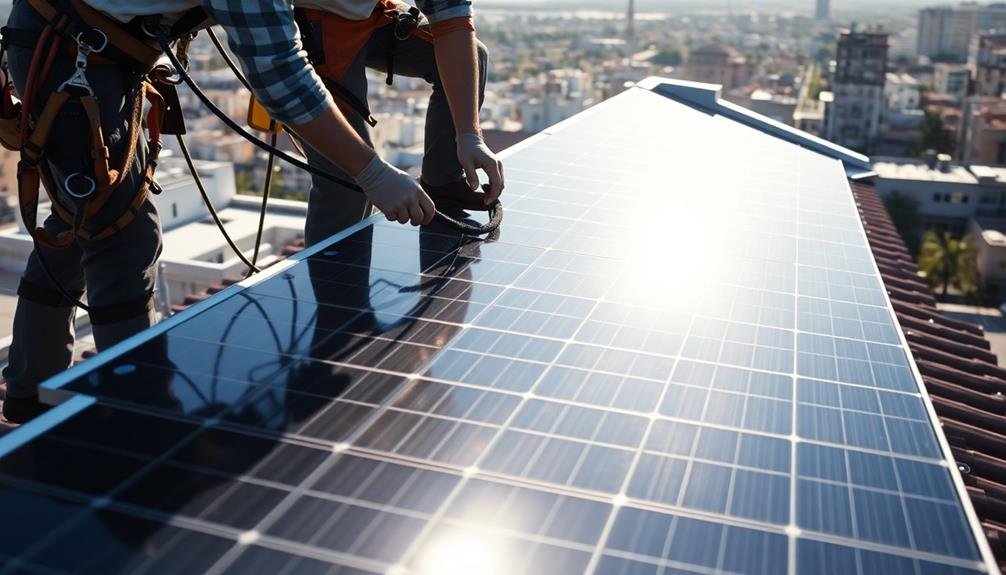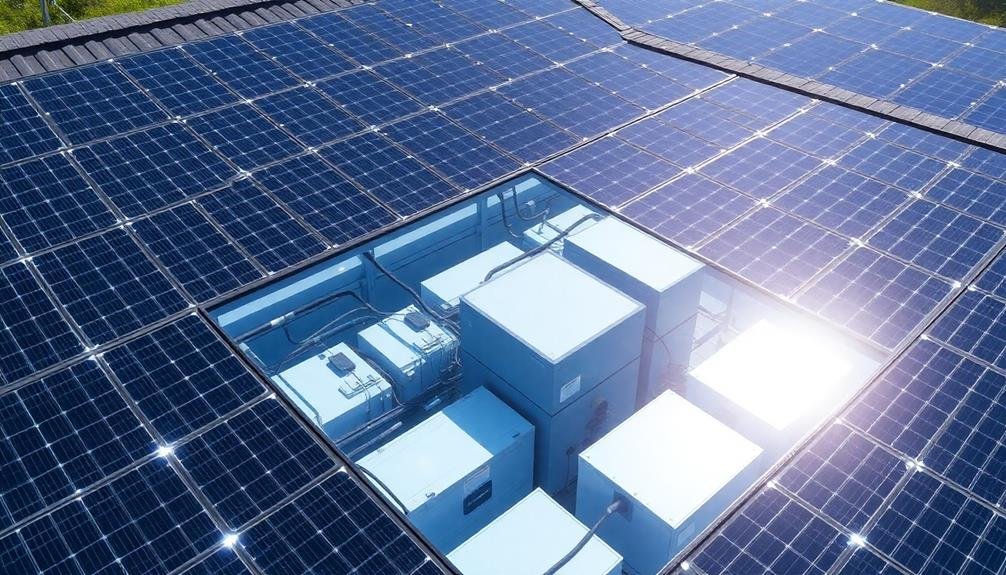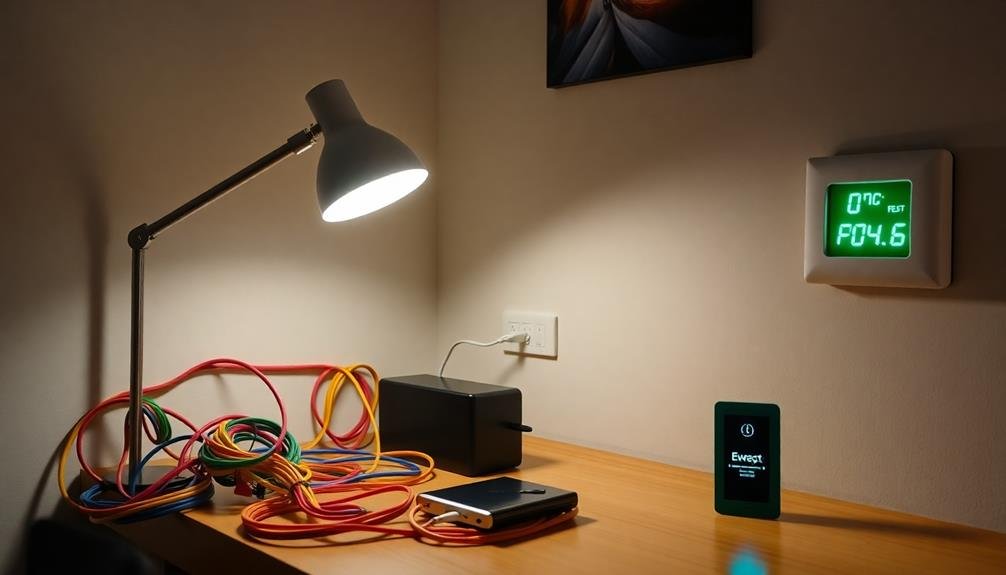When replacing your photovoltaic roof tiles, several factors influence the cost. Your roof's size and complexity play a significant role, as larger or more intricate roofs require more materials and labor. The quality of solar tiles you choose affects both efficiency and longevity. Labor and installation costs vary based on your location and the project's complexity. Your existing roof's condition may necessitate additional repairs or reinforcements. Geographic location impacts material durability and labor rates. Permit and inspection fees can add substantial expenses. Finally, integrating energy storage systems, while beneficial, increases overall costs. Understanding these factors will help you better prepare for your solar roof upgrade.
Roof Size and Complexity

The intricacy of your roof plays an essential role in determining the cost of photovoltaic tile replacement. Larger roofs naturally require more tiles, increasing material costs and labor time.
However, it's not just about square footage; the complexity of your roof's design profoundly impacts expenses. Roofs with multiple angles, dormers, or irregular shapes demand more intricate installation work. You'll need custom-cut tiles to fit around chimneys, vents, and skylights, which adds to both material and labor costs.
Steep pitches also increase difficulty and safety concerns, potentially requiring specialized equipment or additional workers.
Consider the accessibility of your roof as well. If it's challenging for workers to reach or move around on, expect higher labor costs. Roofs with limited access may necessitate the use of cranes or scaffolding, further inflating expenses.
The condition of your existing roof structure matters too. If repairs or reinforcements are needed to support the weight of photovoltaic tiles, you'll face additional costs before installation can even begin.
It's essential to have a professional assessment to identify any structural issues that might complicate the replacement process.
Solar Tile Quality
When considering photovoltaic roof tile replacement, solar tile quality greatly impacts both performance and cost. You'll find that higher-quality solar tiles typically come with a steeper price tag but offer several advantages.
They're often more efficient at converting sunlight into electricity, which means you'll need fewer tiles to meet your energy needs. This can offset the initial cost over time through increased energy production and savings on your utility bills.
Higher-quality tiles also tend to be more durable and weather-resistant, reducing the likelihood of damage and the need for frequent replacements. They may come with longer warranties, providing you with peace of mind and potentially lower long-term maintenance costs.
Additionally, premium solar tiles often have better aesthetic appeal, seamlessly blending with your existing roof design.
However, it's essential to balance quality with your budget and energy requirements. While top-tier solar tiles offer superior performance, mid-range options can still provide excellent results at a more affordable price point.
You should carefully evaluate the specifications, efficiency ratings, and warranties of different solar tile options to determine the best value for your specific needs and circumstances.
Labor and Installation Costs

Beyond the cost of the solar tiles themselves, labor and installation expenses form a significant portion of your overall photovoltaic roof tile replacement budget.
These costs can vary widely depending on several factors, including the complexity of your roof's design, the size of the project, and your location.
You'll need to take into account the expertise required for proper installation. Specialized solar installers command higher rates than general roofers due to their specific training and experience.
The time needed to complete the job also impacts costs, with larger or more intricate roofs taking longer to finish.
Your roof's pitch and accessibility play vital roles in determining labor expenses. Steeper roofs require additional safety measures and equipment, increasing overall costs.
Similarly, if your roof is difficult to access, installers may need special equipment or more time, further driving up expenses.
Don't forget to factor in potential electrical work. You may need to upgrade your home's electrical system to accommodate the new solar tiles, which could involve hiring an electrician.
Additionally, permits and inspections required by local authorities can add to your total installation costs.
Existing Roof Condition
Before diving into photovoltaic roof tile replacement, you'll need to assess your existing roof's condition. The state of your current roof plays an essential role in determining the overall cost and feasibility of installing solar tiles.
If your roof is nearing the end of its lifespan or shows signs of damage, you'll likely need to replace it entirely before proceeding with solar tile installation.
Inspect your roof for issues like missing shingles, leaks, or structural damage. These problems must be addressed before installing photovoltaic tiles to guarantee a stable foundation and prevent future complications.
The age of your roof is also a significant factor. If it's more than 15-20 years old, you might evaluate a complete replacement to avoid having to remove and reinstall the solar tiles prematurely.
Additionally, the roof's pitch, orientation, and shading from nearby trees or structures will impact the efficiency of your photovoltaic system. A south-facing roof with a 30-45 degree pitch and minimal shading is ideal for maximizing solar energy production.
If your roof doesn't meet these criteria, you may need to explore alternative placement options or additional modifications, which can increase overall costs.
Geographic Location

Your geographic location plays an essential role in determining the costs of photovoltaic roof tile replacement.
Regional climate differences can impact the durability and maintenance requirements of your solar tiles, potentially affecting long-term expenses.
Additionally, local installation costs vary considerably across different areas, influenced by factors such as labor rates, market competition, and accessibility of materials.
Regional Climate Differences
The regional climate of your location plays a significant role in determining the costs associated with photovoltaic roof tile replacement. Different climates expose your solar tiles to varying levels of wear and tear, impacting their lifespan and replacement frequency. In areas with extreme temperatures, you'll likely face higher replacement costs due to increased material stress and potential damage.
Consider these climate-related factors affecting your photovoltaic roof tile replacement expenses:
- UV exposure: High UV levels can degrade materials faster
- Temperature fluctuations: Rapid changes cause expansion and contraction
- Humidity: Moisture can lead to corrosion and electrical issues
- Snowfall: Heavy snow loads may require reinforced tiles
- Wind: Strong winds increase the risk of debris damage
If you live in a region with harsh winters, you'll need tiles designed to withstand snow and ice, which can be more expensive.
Coastal areas with high humidity and salt exposure might require corrosion-resistant materials, adding to the cost.
In contrast, moderate climates with stable temperatures and low humidity can lead to lower replacement expenses due to reduced environmental stress on the tiles.
Understanding your local climate's impact on photovoltaic roof tiles helps you better estimate and plan for future replacement costs.
Local Installation Costs
While climate plays a considerable role in replacement costs, your geographic location also heavily influences local installation expenses for photovoltaic roof tiles. Urban areas typically have higher labor costs than rural regions, which can considerably impact your overall expenses.
You'll find that cities with a higher cost of living often charge more for skilled labor, including solar installers and electricians.
The availability of qualified installers in your area can affect pricing as well. If there's a shortage of experienced professionals, you may face higher costs due to limited competition. Conversely, areas with numerous solar companies might offer more competitive rates.
Local regulations and permitting requirements vary by location, potentially adding to your expenses. Some jurisdictions have stricter building codes or require additional inspections, which can increase installation time and costs.
You should also consider the proximity of suppliers and distributors. If you're in a remote area, transportation costs for materials may be higher.
Lastly, local incentives and rebates can offset some of your expenses. Check if your state, county, or utility company offers any financial incentives for solar installations, as these can considerably reduce your overall costs.
Permit and Inspection Fees
Bureaucratic red tape often accompanies the installation of photovoltaic roof tiles, including permit and inspection fees. You'll need to factor these costs into your budget when planning your solar roof replacement. These fees can vary notably depending on your location and the scope of your project.
Typically, you'll encounter several types of permits and inspections:
- Building permit
- Electrical permit
- Structural engineering review
- Fire department approval
- Utility interconnection permit
Each of these may come with its own fee, which can range from a few hundred to several thousand dollars. Some jurisdictions charge a flat rate, while others base the fee on the project's value or system size.
You'll also need to contemplate the time and effort required to navigate the permitting process. This might involve multiple site visits, paperwork submissions, and waiting periods.
In some cases, you may need to hire a professional to handle these tasks, adding to your overall expenses.
To minimize costs, research your local requirements thoroughly and think about working with experienced solar installers who are familiar with the permitting process in your area. They can often streamline the procedure and help you avoid costly delays or mistakes.
Energy Storage Integration

Many homeowners contemplating photovoltaic roof tiles are also exploring energy storage options. If you're thinking about integrating energy storage with your new solar roof, you'll need to factor in additional costs.
Battery systems, like Tesla's Powerwall or LG's RESU, can greatly increase your initial investment. The price of energy storage depends on the capacity you choose and the complexity of installation. You'll typically spend between $5,000 and $15,000 for a residential battery system. This cost includes the battery itself, inverter, and necessary wiring.
If you're retrofitting an existing solar setup, you might face higher installation costs due to potential system incompatibilities.
Don't forget to take into account the long-term benefits of energy storage. You'll be able to use stored solar power during peak hours or outages, potentially reducing your electricity bills and increasing your energy independence.
However, you'll need to weigh these advantages against the upfront costs and the battery's lifespan, which is usually around 10-15 years. Maintenance and eventual replacement of the battery system should also factor into your decision-making process when budgeting for your photovoltaic roof tile project.
Frequently Asked Questions
How Long Does It Take to Replace Photovoltaic Roof Tiles?
You'll find that replacing photovoltaic roof tiles typically takes 1-3 days. However, it can vary depending on your roof's size, the number of tiles being replaced, and the complexity of your solar system's setup.
Can Photovoltaic Roof Tiles Be Recycled After Replacement?
Yes, you can recycle photovoltaic roof tiles after replacement. They contain valuable materials like silicon, glass, and metals. You'll need to find specialized recycling facilities that handle solar panels, as they require specific processing techniques for proper recycling.
Do Photovoltaic Roof Tiles Affect Home Insurance Premiums?
Yes, photovoltaic roof tiles can affect your home insurance premiums. You'll likely see an increase due to higher replacement costs and potential risks. However, some insurers offer discounts for eco-friendly homes, which could offset the increase.
Are There Tax Incentives for Replacing Traditional Roofing With Photovoltaic Tiles?
Yes, you'll likely find tax incentives for switching to photovoltaic tiles. You can claim federal tax credits, and many states offer additional incentives. Check with your local government and energy providers for specific programs available in your area.
How Do Photovoltaic Roof Tiles Compare to Traditional Solar Panels in Efficiency?
You'll find that photovoltaic roof tiles are generally less efficient than traditional solar panels. They typically convert 10-20% of sunlight to electricity, while traditional panels can reach 22% or higher. However, they're more aesthetically pleasing and integrated.
In Summary
You've now explored the key factors influencing photovoltaic roof tile replacement costs. Remember, your roof's size and complexity, the quality of solar tiles, labor expenses, and your existing roof's condition all play vital roles. Don't forget to take into account your location, permit fees, and potential energy storage integration. By weighing these factors carefully, you'll be better prepared to budget for your solar roof upgrade and make an informed decision about this eco-friendly home improvement.





Leave a Reply